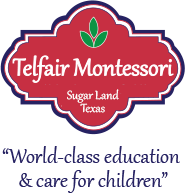Primary 3-5 Years

Children from 3 to 6 years are in a dynamic, expansive time of growth. Maria Montessori called this developmental stage “the absorbent mind.” She observed and identified the natural characteristics of young children:
- Spontaneous interest and deep concentration
- Desire for purposeful movement
- Love of repetition
- Love of order
- Desire for freedom of choice
- Preference of work to play
- Indifference to rewards or punishments
- Love of silence
- Sense of personal dignity
- Early interest in reading and writing
- Spontaneous self-discipline
- Interest in the cosmos and the interrelation of all things
We have designed a “prepared environment” that offers children the opportunity to freely develop these characteristics, which represent the developmental needs of this age period. This Montessori prepared environment offers activities and hands-on materials that correspond to these needs. The environment is structured around four avenues of learning:
- Control of movement through the exercises of practical life
- Sensory education
- Language
- Math
Practical Life
Children in this stage of development have a strong drive for purposeful movement. In our primary Montessori classrooms, you will find materials to help children coordinate and control their movements. For example, there is a set of dressing frames for learning to zip, snap, button, buckle etc. Children also pour, cut, fold, scoop, clean and sweep. These simple “practical life” activities lead to concentration, coordination of movement, independence and the internal sense of order.
Sensory Education
Children of this age are also very drawn to activities that engage the five senses. Montessori materials are designed to clearly isolate specific concepts such as length, weight, shape, size and color. Children learn to compare and contrast using their senses of smell, taste, touch, sight and hearing.
Language Arts
During this period, children have an innate desire to learn new words, so vocabulary is presented with new materials and books every day. Using the Montessori Method, we have also discovered that children age three to five are vitally interested in learning to read and write. A phonetic approach to reading begins with sandpaper letters to identify sounds and shapes, and to trace letters, training the muscles needed for writing. The Montessori Method provides a sequence of simple steps that gently guides children to early reading and writing mastery. With the moveable alphabet, children construct words, phrases, sentences and stories in preparation for written expression.
Math
Using the Montessori Method, we have developed a sequence of concrete materials that illustrate basic mathematical concepts. Hands-on experiences with these materials lead children to an understanding of numbers, the decimal system and four operations of addition, subtraction, multiplication and division.
Cultural Education
Music, art, foreign language, and physical education are part of the integrated cultural curriculum. Children also experience the basics in geography, history, and life sciences in the primary classrooms.
| Full Week (Mon – Fri) | Program | Hours | 3 to 6 years |
| Full School Day | 8:30 AM – 3:00 PM | Offered | |
| Half School Day | 8:30 AM – 12:00 PM | Offered | |
| Extended-Day Flex | 6:30 AM – 6:30 PM | Offered | |
| Lunch | Offered | ||
| Extra-Curricular Activities | 3:00 PM – 6:30 PM | Per Class | |
| Partial Week (Mon, Wed, Fri) | Program | Hours | 3 to 6 years |
| Full School Day | 8:30 AM – 3:00 PM | Offered | |
| Half School Day | 8:30 AM – 12:00 PM | Offered | |
| Lunch | Offered | ||
| Extra-Curricular Activities | 3:00 PM – 6:30 PM | Offered |
